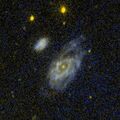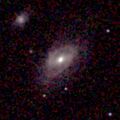Astronomy:NGC 1241
| NGC 1241 | |
|---|---|
 NGC 1241 by Hubble Space Telescope | |
| Observation data (J2000 epoch) | |
| Constellation | Eridanus |
| Right ascension | 03h 11m 14.6s[1] |
| Declination | −08° 55′ 20″[1] |
| Redshift | 0.016652 ± 0.000020 [1] |
| Helio radial velocity | 4,052 ± 4 km/s[1] |
| Distance | 144 ± 36 Mly (44.1 ± 11 Mpc)[1] |
| Apparent magnitude (V) | 12.2 [2] |
| Characteristics | |
| Type | SB(rs)b [1] |
| Apparent size (V) | 3.3′ × 2.2′ |
| Notable features | Seyfert galaxy |
| Other designations | |
| ARP 304, MCG -02-09-011, VV 334a, Holmberg 068A, PGC 11887[1] | |
NGC 1241 is a spiral galaxy located in the constellation Eridanus. It is located at a distance of circa 150 million light years from Earth, which, given its apparent dimensions, means that NGC 1241 is about 140,000 light years across. It was discovered by William Herschel on January 10, 1785.[3] It is classified as a Seyfert galaxy.
NGC 1241 interacts with its smaller companion NGC 1242, forming a pair collectively known in the Atlas of Peculiar Galaxies as Arp 304.
Characteristics
NGC 1241 is a barred spiral galaxy seen at an inclination. It has two well defined dusty spiral arms, and thus is characterised as a grand design spiral galaxy.[4] The bulge is boxy, characteristic of a barred galaxy, with the arms emerging from each end of the bar, with the north one appearing more tightly wound than the southern.[5] The main arms branch into smaller ones.
A circumnuclear ring with active star formation has been detected in the central region of the galaxy.[6] It appears clumpy and inclined and measures 5.6 × 3.4 arcseconds in diameter, lying just inside the inner Lindblad resonance. A faint spiral pattern with leading arms has been found to emanate from it in Paα emission, while in Ks and J band, the pattern appears trailing.[7] NGC 1241 is one of the few galaxies with known trailing features in the nuclear regions, with the other being NGC 6902.[8] Inside the circumnuclear ring was detected a bar like feature 1.6 arcseconds long that is almost perpendicular to the main bar of the galaxy.[7]
The nucleus of NGC 1241 has been found to be active and it has been categorised as a type II Seyfert galaxy.[9] The most accepted theory for the energy source of active galactic nuclei is the presence of an accretion disk around a supermassive black hole. The mass of the black hole in the centre of NGC 1241 is estimated to be 107.46 (29 million) M☉.[10]
The star formation rate of NGC 1241 is estimated to be 3.07 M☉ per year based on the H-alpha flux.[11]
Nearby galaxies
NGC 1241 forms a pair with NGC 1242, which lies at an angular separation of 1.6 arcminutes. NGC 1243 lies 3.1 arcminutes away, but it has been identified as a double star in our galaxy. According to Garcia et al. the pair of galaxies is part of a galaxy group known as LGG 84, which also includes the galaxies NGC 1247, MCG -02-09-006, and Markarian 1071.[12] A more recent study placed NGC 1241 in the same group as the galaxies NGC 1185, NGC 1204, NGC 1214, NGC 1215, NGC 1238, and NGC 1247.[13]
Gallery
NGC 1241 and NGC 1242 as seen by Hubble Space Telescope
NGC 1241 in ultraviolet by GALEX
NGC 1241 by DSS
See also
- NGC 7469 - another interacting Seyfert galaxy with a circumnuclear star formation ring
References
- ↑ 1.0 1.1 1.2 1.3 1.4 1.5 1.6 "NASA/IPAC Extragalactic Database". Results for NGC 1241. http://ned.ipac.caltech.edu/cgi-bin/nph-objsearch?objname=NGC+1241.
- ↑ "Revised NGC Data for NGC 1241". http://spider.seds.org/ngc/revngcic.cgi?NGC1241.
- ↑ Seligman, Courtney. "NGC 1241 (= PGC 11887, and with NGC 1242 = Arp 304)". https://cseligman.com/text/atlas/ngc12.htm#1241.
- ↑ Martini, Paul; Regan, Michael W.; Mulchaey, John S.; Pogge, Richard W. (June 2003). "Circumnuclear Dust in Nearby Active and Inactive Galaxies. I. Data". The Astrophysical Journal Supplement Series 146 (2): 353–406. doi:10.1086/367817. Bibcode: 2003ApJS..146..353M.
- ↑ Eskridge, Paul B.; Frogel, Jay A.; Pogge, Richard W.; Quillen, Alice C.; Berlind, Andreas A.; Davies, Roger L.; DePoy, D. L.; Gilbert, Karoline M. et al. (November 2002). "Near-Infrared and Optical Morphology of Spiral Galaxies". The Astrophysical Journal Supplement Series 143 (1): 73–111. doi:10.1086/342340. Bibcode: 2002ApJS..143...73E.
- ↑ Boker, T.; Calzetti, D.; Sparks, W.; Axon, D.; Bergeron, L. E.; Bushouse, H.; Colina, L.; Daou, D. et al. (September 1999). "The NICMOS Snapshot Survey of Nearby Galaxies". The Astrophysical Journal Supplement Series 124 (1): 95–126. doi:10.1086/313253. Bibcode: 1999ApJS..124...95B.
- ↑ 7.0 7.1 Diaz, Ruben J.; Dottori, Horacio; Vera-Villamizar, Nelson; Carranza, Gustavo (10 November 2003). "Circumnuclear Structures in the Interacting Seyfert Galaxy NGC 1241: Kinematics and Optical/Infrared Morphology". The Astrophysical Journal 597 (2): 860–869. doi:10.1086/381215. Bibcode: 2003ApJ...597..860D.
- ↑ Kim, Woong-Tae; Seo, Woo-Young; Stone, James M.; Yoon, Doosoo; Teuben, Peter J. (1 March 2012). "Central regions of barred galaxies: two-dimensional non-self-gravitating hydrodynamic simulations". The Astrophysical Journal 747 (1): 60. doi:10.1088/0004-637X/747/1/60. Bibcode: 2012ApJ...747...60K.
- ↑ Dahari, Oved; de Robertis, Michael M. (July 1988). "A statistical study of properties of Seyfert and starburst galaxies". The Astrophysical Journal Supplement Series 67: 249. doi:10.1086/191273. Bibcode: 1988ApJS...67..249D.
- ↑ Bian, W.; Gu, Q. (March 2007). "The Eddington Ratios in Seyfert 2 Galaxies with and without Hidden Broad-Line Regions". The Astrophysical Journal 657 (1): 159–166. doi:10.1086/510708. Bibcode: 2007ApJ...657..159B.
- ↑ Theios, Rachel L.; Malkan, Matthew A.; Ross, Nathaniel R. (4 May 2016). "Hα imaging of nearby Seyfert host galaxies". The Astrophysical Journal 822 (1): 45. doi:10.3847/0004-637X/822/1/45. Bibcode: 2016ApJ...822...45T.
- ↑ Garcia, A. M. (1993). "General study of group membership. II - Determination of nearby groups". Astronomy and Astrophysics Supplement Series 100 (1): 47–90. ISSN 0365-0138. Bibcode: 1993A&AS..100...47G. http://cdsarc.u-strasbg.fr/ftp/J/A+AS/100/47/table2.dat.
- ↑ Crook, Aidan C.; Huchra, John P.; Martimbeau, Nathalie; Masters, Karen L.; Jarrett, Tom; Macri, Lucas M. (October 2008). "Erratum: "Groups of Galaxies in the Two Micron All Sky Redshift Survey" (ApJ, 655, 790 [2007])". The Astrophysical Journal 685 (2): 1320–1323. doi:10.1086/590385. Bibcode: 2008ApJ...685.1320C.
External links
- NGC 1241 on WikiSky: DSS2, SDSS, GALEX, IRAS, Hydrogen α, X-Ray, Astrophoto, Sky Map, Articles and images
- NGC 1241 on SIMBAD
 |





